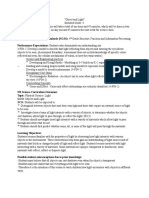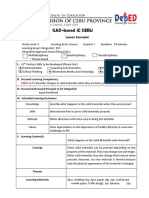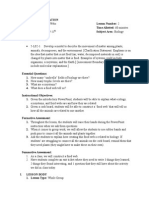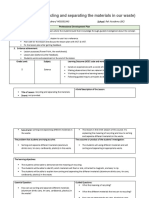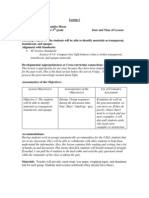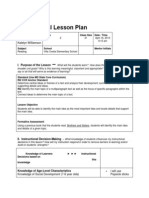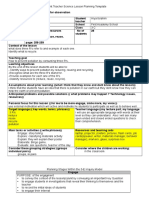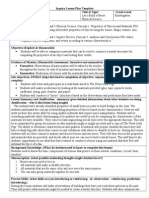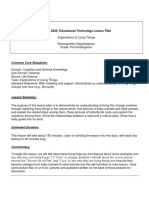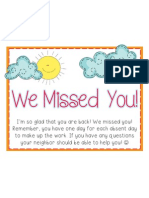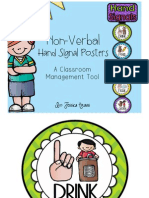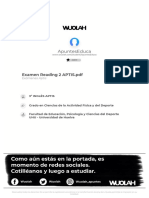0 ratings0% found this document useful (0 votes)
80 viewsAssessments
Assessments
Uploaded by
api-242320403Copyright:
© All Rights Reserved
Available Formats
Download as DOCX, PDF, TXT or read online from Scribd
Assessments
Assessments
Uploaded by
api-2423204030 ratings0% found this document useful (0 votes)
80 views33 pagesOriginal Title
assessments
Copyright
© © All Rights Reserved
Available Formats
DOCX, PDF, TXT or read online from Scribd
Share this document
Did you find this document useful?
Is this content inappropriate?
Copyright:
© All Rights Reserved
Available Formats
Download as DOCX, PDF, TXT or read online from Scribd
Download as docx, pdf, or txt
0 ratings0% found this document useful (0 votes)
80 views33 pagesAssessments
Assessments
Uploaded by
api-242320403Copyright:
© All Rights Reserved
Available Formats
Download as DOCX, PDF, TXT or read online from Scribd
Download as docx, pdf, or txt
You are on page 1of 33
Recycling Materials: Mini Unit
By: Katelyn Shockey
EDU429/ Prof. Sailers
Classifying Materials
Name: Katelyn Shockey Time Allotted: 40 Minutes
Grade Level: 2
nd
Grade Subject(s): Science
Essential Question: What is recycling (reduce, reuse, recycle)?
Materials Required:
5 Hula-hoops
Recyclable Materials
Website: PBS KIDS. (n.d.). Science. [Video File]. Retrieved from
http://pbskids.org/video/?category=Science&pid=TUmOlfBGfkzTqaVD_U0nEZf
_XnkKyjkV
o About: (Play the whole video) This video engages students helping
them to understand the value of recycling and the importance of
classifying materials. If students are struggling to understand how to
classify materials this video can help model what exactly classifying
materials looks like.
Gibbons, G. (1992). Recycle!: A handbook for kids. Boston, MA: Little Brown &
Company.
o About: This lively and informative handbook explains the process of
recycling from start to finish. The book focuses on 5 different types of
rubbish - paper, glass, aluminum cans, plastic and Styrofoam.
Reflection Journal
Michigan Content Expectations:
2-PS1-1.
Plan and conduct an investigation to describe and classify different kinds of materials
by their observable properties.
CCSS.ELA-Literacy.W.2.8.
Recall information from experiences or gather information from provided
sources to answer a question.
Objective(s):
Objective 1 - TLW: classify (comprehension) different kinds of materials by their
observable properties as a class through actively participating in a material sort in
which 15 out of 20 objects will need to be classified correctly into a group.
Objective 2 - TLW: recall (knowledge) information from a provided source to answer a
question individually through recording three of the five classifications groups in the text
scoring a minimum of 3 out of 5 on the assessment.
Assessment:
(Formal, Summative) Objective 1 (Reflection Journal: Picture) The learner will
classify different kinds of materials by their observable properties as a class through
actively participating in class during a materials sort in which 15 out of 20 objects
will need to be classified correctly into a group. Therefore, I will provide students
with the five hula-hoops, classification cards, and twenty recyclable objects. The
students will have to work as a team to create and test their understanding. Each
student would be able to select one material and would have to determine where it
went do to its properties. Lastly, students are responsible for drawing their creation
into the image section of their Reflection Journal. I would also take a picture of the
results so students could refer back to what they did.
Paper Plastic Styrofoam Glass Aluminum
(Formal, Interim) Objective 2 (Reflection Journal: Ticket Out The Door) The learner
will recall information from a provided source (recycling book) to answer a question
individually through recording three of the five classifications groups in the text scoring a
minimum of 3 out of 5 on the assessment. The students will be encouraged to listen for
the classification types as we read a book together. During reading students can take
notes in their reflection journal. At the end of the lesson I will ask students to record three
of the five classification categories.
Instructional Procedure: What information do students need to accomplish
the objective?
1. Anticipatory Set: (Allotted Time 8 minutes)
a. Attention Grabber
1. Sid Recycling Video
1. This video helps us understand the value of recycling
and the importance of classifying materials. If students
are struggling to understand how to classify materials
this video can help model what exactly classifying
materials looks like. Lets take a moment to watch the
few clips.
b. Review: Recently we learned about the importance of making
observations and recording your findings.
c. Today we are going to be working on grouping or classifying objects
based on our observations and what we think they are made of.
Inquiry
1.Does anyone know what it means to classify something? (It means
to organize), ok, does anyone else want to share the meaning of the
word?
d. While we are learning today I need your help. We have a lot of activities
to get through and in order to get to all the fun activities I need you to help
me by:
1.Listen carefully (point to your ear)
2.Respect yourself and others (point to yourself and then someone
else)
3.Strive to do your best (superman)
State Purpose and Objective of Lesson: (Allotted Time 2 minutes)
e. Today we are going to use our observational skills from out last science
lesson and learn to classify materials. But before we begin do you know
what classify means. Classify is a fancy word for organize. So today we
are going to organize trash into different recycling groups like we saw in
the video.
f. Understanding how to classify material is important so we can organize
large groups of items. Classifying materials also helps us to observe
patterns.
g. Our lesson today directly related to what we have been learning about
making observations. Todays lesson is important because in the future we
will be discussing the idea of re-using materials. In order to successfully
re-use materials we must know how to classify them. Does what we are
learning about sound familiar? Thats, right! Last week we talked about
recycling and this week we are learning how to organize garbage so we
can recycle properly and take better care of our earth.
2. Instruction: (Allotted Time 30 minutes)
a. Direct Interactive Instruction:
1.TTW Discuss what the students observed in the movie clip
asking the students.
1. What did the teacher pull out? Thats right trash.
2. How did she re-use the trash in the classroom? Yeah,
she used the cans as crayon holders.
3. How did they organize the trash? That is right, they
sorted paper, glass, and plastic.
2.TTW Today we are going to sort some materials but before we
do we need to learn more. We are going to take time to read the
book Recycling! A Handbook for Kids. Within this book there
are several groups mentioned. As we read make sure you write
down any categories you hear. If you can remember a category
would be (paper, plastic, or some other thing that makes up trash).
3.TSW get out their Reflection Journal and begin an entry for
classifying materials. Students will listen as the teacher reads
through the book and engages students through questioning.
1. What do you think will happen next? Would anyone else
like to share?
2. Why do you think that will happen next?
4.Read the book
5.TTW After reading the teacher will ask students if they could
identify any of the recycling groups. The class would take time to
discuss what they learned from the book.
b. Modeling:
1.After reading the teacher would take time to model our next
activity.
2.Now that we have watched a brief movie, and read more about
recycling we are going to practice sorting materials based off of
what they are made from. We have five hula-hoops, recycle labels,
and a lot of trash. How can we organize this into piles? Does
anyone else have any ideas? Is that the best way we could do it,
why? You could label each hoola-hoop.
3.Yeah we could label each hula-hoop. Do you think we should keep
them close or spread them out? Could I get a couple students to
help me spread out the hula-hoops? That is great thank you I
appreciate how you did that quietly. Now that we have the hula-
hoops laid out can I have five more students place a label above
each hula-hoop. So as you can see we now have five recycling
groups. We have plastic, paper, glass, aluminum, and Styrofoam.
Next I would select an item and ask the students where they think I
should place a piece of old paper. After students provide their
suggestions I would ask them:
1. What is this made of? Does anyone else have any ideas?
Great job, it is made of paper so I should put this old paper
in the paper hula-hoop. After modeling this activity I would
ask the student to help place an item in the correct location.
c. Guided Practice:
1.As students imitate sorting I would make sure they understand that
they need to observe the material, determine what it is made from,
and then place the item in the right group.
2.After students put several items in place I would ask them to draw
the hula-hoops and items in their reflection journal.
3.If students finish early I would encourage them to locate items in
the room that can be recycled to draw into their hula-hoops on their
reflection journal.
4.While students are completing this assignment I would monitor
them to make sure students are not practicing errors.
d. Independent Practice:
Inquiry
i. When students have proven that they understand how to observe,
and correctly classify items I would have them move onto
answering the ticket out the door questions. I would ask the
students:
o (Reflection Journal: Ticket Out The Door) What were
three of the five recycling groups we used to sort trash
today?
If students finish early I would ask them to list
items they placed in each of the three categories.
ii. Then I would provide students with time to record any question
they have as well as reflect on their level of understanding.
3. Differentiated Consideration (Adjust instruction and assessments, tools,
resources or activities for students who):
Finish quickly: If students finish the task quickly then I would ask them to add
different materials they see around the classroom that could be placed in each
recyclable group to their image. This activity would help students to become
aware of how much around us is recyclable.
Struggle to complete activity/assessments: If a student is struggling to complete
the activity then we would take time to help scaffold based off of what they
already know about making observations. We will take time to review the Sid
movie so students could see an example of sorting materials.
Show proficiency early: If a student displays early proficiency I will ask them to
take it one step further by completing one of several options:
o List recyclable materials they see around the classroom.
o Research how you can help to recycle
o Invent a new way to reuse recyclable materials.
Still not proficient near end of lesson: If the student is still not proficient by the
end of the lesson I would take time outside of class to review what they
understand and adapt my teaching to meet their needs.
Multiple Intelligences:
Kinesthetic - The learner will classify trash into recycling groups based off of the
materials the objects are made from.
Visual The learners will watch a movie and see a model of how students and
teachers can re-use materials in a classroom. The students will also observe how
to sort trash based off of what its made from.
Interpersonal The students will work as a class to classify and sort trash into
recyclable materials.
Intrapersonal The students will work individually in their reflection journal to
record notes, an image of their classification, ticket-out-the-door, record any other
questions they have and lastly to record how confident they feel with the new
material learned.
Logical The students will have to identify three of the five recycling groups
they learned about through the story.
Verbal/ Linguistic - The students will be discussing in groups, and also recording
data on their reflection journal.
5. Closure: (5 min.)
a. Reinforce/Restate the objectives:
i. Today we learned how to classify materials based off of their
observable prosperities. We also recalled information from our book
and learned about five recycling groups.
b. Tell me:
i. What were three of the five recycling groups that were discussed
within our text. We used these categories to classify our materials in
the hula-hoops.
c. Review: Last week we learned about observing and recording what we
notice about an object. Today we applied our knowledge while we organized
and classified materials into differing categories. Next, we will be using what
we have learned about grouping recycling materials as we look at
repurposing and reusing materials in the future.
d. Thank you for your focus. It was my pleasure to teach you today! I hope
that you enjoyed learning about classifying objects and look forward to
seeing you tomorrow.
4. References:
Gibbons, G. (1992). Recycle!: A handbook for kids. Boston, MA: Little Brown &
Company.
PBS KIDS. (n.d.). Science . Sid the Science Kid. Retrieved from
http://pbskids.org/video/?category=Science&pid=TUmOlfBGfkzTqaVD_U0n
EZf_XnkKyjkV
Sample Assessment (Reflection Journal)
Assessment Name: Reflection Journal, Name Katelyn Shockey
Our Earth, My Impact
Purpose: Summative
1. Who will score the assessment? As the teacher I will be the one scoring
this assessment in order to demine what data I need to use to improve for
the future. Typically I do desire to score assessments unless it is something I
can have other students help score someone elses journal. Because this is a
summative assessment within the students personal Journal I desire to score
the test to keep confidentiality.
2. Describe the info (data) that will be collected. I will take note of any
problems that consistently were answered incorrectly to determine why the
problem was missed. When looking through tests I will look for patterns to
see if the question was confusing, if students all selected the same incorrect
answer, or it was simply not something the class had grasped yet.
3. What will the teacher do with the data? How will it be analyzed? I will
use data as a point in reference to direct my instruction, therefore if I have
seen many students are struggling I will re-teach the material. If the students
do well on the assessment I will know that my students are ready to move
on. I hope to analyze data by either inserting in into some for of visual
diagram whether that be a pie chart, or table.
a. What will be the proficiency levels?
i. Mastery: Within this assessment in order to show mastery of
the material students must score 15 out of 20 on the reflection
journal picture, and a 3 on the ticket out the door at the bottom
of the journal entry.
ii. Proficient: In order for students to score proficient students
must record between 10 and 15 items correctly within their
picture diagram, and 2 points on the ticket out the door portion
of the assessment.
iii. Semi-proficient: In order to score semi-proficient students
must score between 5 and 10 on the picture portion of the
journal entry and a score of 1 on the ticket out the door.
iv. Not Proficient: To score below the proficiency level students
must score between a zero and five on the picture portion of
the journal entry by classifying five or less items.
b. Will it be used for grading? If so, how? The journal entry will be
used to grading and will help me understand if the student has met
our two learning targets for the lesson.
4. Sample document of how the data will be recorded.
Student Criteria/ Problem Ability
1 Goal to score 15 or more Mastery (20pts)
out of 20 (on the picture)
To score 3 out of 3 (on the
ticket out the door)
Proficient (2pts)
Did not recall
category names
2 Goal to score 15 or more
out of 20 (on the picture)
Proficient (13pts)
Struggled with
categories
To score 3 out of 3 (on the
ticket out the door)
Semi-proficient (1pt)
Missing categories of
objects
5. Describe intentional, possible interventions for low scoring students
and enrichments for high scoring students, if any.
a. Finish quickly: If students finish the task quickly then I would ask
them to add different materials they see around the classroom that
could be placed in each recyclable group to their image. This activity
would help students to become aware of how much around us is
recyclable.
b. Struggle to complete activity/assessments: If a student is
struggling to complete the activity then we would take time to help
scaffold based off of what they already know about making
observations. We will take time to review the Sid movie so students
could see an example of sorting materials.
c. Show proficiency early: If a student displays early proficiency I will
ask them to take it one step further by completing one of several
options:
i. List recyclable materials they see around the classroom.
ii. Research how you can help to recycle
iii. Invent a new way to reuse recyclable materials.
d. Still not proficient near end of lesson: If the student is still not proficient
by the end of the lesson I would take time outside of class to review what
they understand and adapt my teaching to meet their needs.
6. Describe any plans for how students may track their scores. In order to
help students track their grades I would give the assessment back with the
incorrect answers circled and ask the students to try to solve the question
again or to work with me during silent work time so I can help them and see
their process. Once students have identified what the answer is I will ask
them, what happened the first time? to help students identify mistakes and
to help them look to improve their own learning. I would also provide
students with a chart to help them see what we will do, and have the student
plug in their scores so they can monitor their own progress as well and be
empowered as self motivated learners.
7. Describe plans for how the outcomes will be communicatedwith
whom, next steps, etc. In order to communicate the outcomes I would
grade the tests, and analyze the data so that I can communicate the overall
out come to parents, and other staff members more efficiently. I will also use
several samples of work to help reveal how students did to support my data.
Reflection Journal
Our Earth, My Impact
Name __________________________________
Teacher ______________________________
Directions (for students)
1) Write your name on the front of the Reflection
Journal.
2) After every lesson in our unit plan, you will be asked to
fill out a journal entry or reflection. This reflection will
usually contain a notes, image, ticket-out-the-door
section as well as stars on the bottom of the page.
Notes What are we learning today?
o This section is to be used for any notes or thoughts
you have as you are learning.
Image What does it look like?
o The box is to be used for any visuals we discuss or for
you to draw an image of an idea we are learning about.
Ticket out the Door! Show me what you know!
o This section is a time to show me what you know. At
the end of each class I will take time to ask two
questions and the students will record the question
and their response.
Questions I wonder
o If you have any remaining questions please record
them in the question section.
Star (Understanding) How much do you understand?
o This is a rating to let me know how much you
understand. If you feel very confident in your learning
and could help teach someone else the content fill in
three stars; if you feel like you are getting the
information and can practice color in two stars; and
lastly if you are having a hard time color in one star
and lets talk so I can help you more.
Example Page
Journal Entry # _______________ Date: ________________
Notes: Image:
_________________________________________________
_________________________________________________
_________________________________________________
_________________________________________________
_________________________________________________
_________________________________________________
_________________________________________________
____________________________
_________________________________________________
_________________________________________________
_________________________________________________
_________________________________________________
Ticket Out The Door!
1)_______________________________________________
_________________________________________________
_________________________________________________
_________________________________________________
2)_______________________________________________
_________________________________________________
_________________________________________________
_________________________________________________
Questions:
_________________________________________________
_________________________________________________
_________________________________________________
_________________________________________________
Star (Understanding)
1 Lets Work Together! 2 Good!
3 Awesome!
Reflection Journal: Picture Rubric
Scoring
Standard:
2-PS1-1.
20-15
(Mastery)
15-10
(Proficient)
10-5
(Semi-
Proficient)
5-0 (Not
Proficient)
Located in
the right
category
(paper,
glass,
aluminum,
plastic, and
Styrofoam)
Fifteen or
more items
were located
correctly in
their
classification.
Between ten
and fifteen
items were
located
correctly in
their
classification.
Between five
and ten items
were located
correctly in
their
classification.
Between zero
and five
items were
located
correctly in
their
classification.
Reflection Journal: Ticket Out The Door Rubric
Scoring
Standard:
CCSS.ELA-
Literacy.W.2.8.
3 (Mastery) 2
(Proficient)
1 (Semi-
Proficient)
0 (Not
Proficient)
Classification
(Example;
plastic, paper,
Styrofoam,
glass, and
aluminum)
Three or more
classifications
are recorded.
Two
classifications
are recorded.
One
classification
is recorded.
No
classifications
are recorded.
Object Comparison
Name: Katelyn Shockey Time Allotted: 40 minutes
Grade Level: 2nd Grade Subject(s): Science
Essential Question: What is recycling (reuse, reduce, recycle)?
Materials Required:
Bottles
Card board
Chopsticks
Styrofoam
Rubber bands
Cans
Glue
Tape
Scissors
Tub (for water)
Discovery Sheet
Discovery Reflection
PowerPoint
Unit Journal
Michigan Content Expectations:
K-20ETS1-3.
Analyze data from tests of two objects designed to solve the same problem to
compare the strengths and weaknesses of how each performs.
http://www.corestandards.org/ELA-Literacy/W/2/8/
CCSS.ELA-LITERACY.W.2.8
Recall information from experiences or gather information from provided
sources to answer a question.
Objective(s):
Objective 1 TLW: Analyze (Analysis) data from the testing of two objects designed
to solve the same problem and compare the strengths and weaknesses of how each
performs on an individual formal formative assessment by completing six out of the
seven of the sections on their discovery sheet with one hundred percent accuracy.
Objective 2 TLW: Recall (Knowledge) information from experiences to answer
questions on the individual discovery reflection assessment and will demonstrate
proficiency by earning three points or more on the assessment.
I can statement:
I can analyze data from the testing of two objects and recall information from
experiences to answer certain questions.
Assessment:
Discovery Sheet (Formal Formative):
The students will work collaboratively, but will individually complete the discovery
sheet. The discovery sheet will be their formal formative assessment and will assess
objective one. This assessment will be completed during the guided practice portion
of the lesson. The data gained from this assessment will be used to guide future
instruction. This assessment will assist the teachers in knowing if the students
understand the material and then the teachers will adjust instruction accordingly.
Discovery Reflection (Formal Summative):
This formal summative assessment will be given at the end of the lesson. This
assessment will be used to assess what the students have learned throughout the
lesson. The data generated from this assessment can be used to understand what
percent of the classroom understood the material, who excelled, who struggled, and
which questions were most often answered incorrectly. If students struggle we will
reteach the material to those students and offer them a redo. If the students are
proficient they will move on to the next lesson.
Instructional Procedure:
1. Anticipatory Set: (3 Min)
a. Good afternoon scientists! Today we will be continuing our unit on
Recycling and we will be using what we have learned about classifying
materials to solve a problem.
b. I have a problem that we were hoping you could all help us with.
c. Describe penny problem. Display picture.
- Mr. Penny needs to get across to the other side.
- How can he get there?
- Discussion.
- Write ideas on the board
d. Those are some great ideas!
2. State Purpose and Objective of Lesson: (2 min.)
a. What: As a class we will be creating and testing two objects to solve the
problem we discussed. After we test our objects we will compare the
strengths and weaknesses of each object and answer questions based off of
our experience.
b. Why: Today we are going to learn to become problem solvers. This is
important because in life you will have to use what you know (background
knowledge) , and what you have (resources) to solve problems.
3. Instruction: (30 min.)
a. Behavioral Expectations: While we become expert problem solvers and
work in groups today we will need your help to:
1. Listen carefully (point to your ear)
2. Respect yourself and others (point to yourself and then someone
else)
3. Strive to do your best (superman)
b. Direct Interactive Instruction: (5 min)
i. Still have picture displayed.
ii. Today we are going to get to reuse these materials to create
objects that can help Mr. Penny make it to the other side.
iii. This object needs to be able to float and be pushed (propelled) by
wind.
iv. We are going to test our objects by placing them in this container
and watching to see if they can carry Mr. Penny to the other side.
Reference picture.
v. Explain instructions. (PowerPoint)
- Create an object with your team.
- Use the materials provided. All materials may not be the same.
-The object should float.
-The object should be able to be pushed (propelled) by the wind.
-Answer questions on the discovery sheet.
vi. Pass out and go over discovery sheet. Take time to explain each
part within the worksheet and see if any students have
questions.
vii. (Finger Check) Ask if anyone has questions. (Check for
understanding)
viii. Divide students into two teams.
c. Work Time: (10 min)
i. Students will work together to create their team objects.
ii. We will walk around to each group and observe their group work
and assist when needed.
d. Experiment: (5min)
i. Students will test their objects three times.
ii. Students will complete the observation portion of the backside of
their discovery sheets.
iii. Teachers time objects.
e. Discussion: (5 min)
- Have the teams share data from their experiments. (write on the
board)
-Think-pair-share: Have students discuss the strengths and weakness
of their objects with your team.
- As a class compare the strengths and weakness of the two objects.
(write on the board)
- Students will complete the strengths and weaknesses portion of
their discovery sheets.
f. Independent Practice: (3 min)
- Students will individually complete the discovery reflection sheet.
4. Differentiated Consideration (Adjust instruction and assessments, tools,
resources or activities for students who):
Finish quickly: If students finish the task quickly then we will ask them to draw a
new design and note the changes they made and why.
Struggle to complete activity/assessments: If a student is struggling to complete
the activity then we would take time to help scaffold based off of what they
already know about making an object float. We will take time to review the
process that we modeled and try to use learning styles which are suited to the
student I am working with.
Show proficiency early: If a student displays early proficiency I will ask them to
take it one step further by completing one of several options: research how to
improve your model, create a new model modifying issues within your other
model, lastly they could research why their objects float or a different clarifying
question they may have.
Still not proficient near end of lesson: If the student is still not proficient by the
end of the lesson I would take time outside of class to review what they
understand and adapt my teaching
Multiple intelligence:
Kinesthetic - The learner will investigate through trial and error as they work to
create a floating object through experimentation.
Visual We will demonstrate what the learners must achieve through drawing
and interacting on the smart board to help students understand the problem and to
come up with solutions. The students will be creating objects from recyclable
materials to solve our problem.
Interpersonal The students will work in groups to create their object and
discuss as a class possible solutions.
Intrapersonal The students will work individually on their discover sheet and
complete the final discovery reflection individually.
Logical The students will be problem solving and asked to explain their
reasoning for why they created their project the way they did.
Verbal/ Linguistic - The students will be discussing in groups, and also recording
data on their discovery worksheet.
5. Closure: (2 min.)
a. Reinforce/Restate the objectives:
i. Today we learned how to solve the problem we discussed and
helped Mr. Penny get across the water. We reflected on our process
and results to discover what went well and what we would improve if
we were to remake the experiment.
b. Journal Entry:
i. What you did learn today?
ii. What would you do differently if you were to try to solve the
question again?
c. Review: Throughout our last three weeks we have been learning about
materials, we have learned how to describe, identify, and classify materials.
Today we used our knowledge of materials to help us solve a problem and
help Mr. Penny.
d. Thank you for your focus. It was our pleasure to teach you today! I hope
that you enjoyed learning about comparing strengths and weaknesses and
how we can use materials to solve a problem.
Photograph for Power Point Example
Assessment Name Finger Check Name Katelyn Shockey
Purpose: Informal Formative
FOR INFORMAL FORMATIVE ASSESSMENTS:
1. Description of the assessment. This check for understanding will ask
students if they understand the direction and students will respond by
holding up 1,2, or 3 fingers to their chest to display their understanding.
What each number of fingers mean is explained below:
a. One finger - I do not understand
b. Two fingers - I understand some of it
c. Three fingers - I understand it well enough to explain it to my
neighbor
2. Formative Assessment Process Strategy (FAP) usedif any
a. None
3. Plan for how I will use the informal data:
a. If most of the students show understanding, then I will move on
to instruct more material.
b. If most of the students dont show understanding, then I will ask
for questions and reteach. In order to gather data I will write down
students individual numeral responses. This data will inform me of
the students level of understanding.
Day 2 Assessment Finger Check
When: This assessment will be given at the end of the modeling portion.
Why: The Finger check will assess students understanding of how to complete the
observation sheet.
Description: This check for understanding will ask students if they understand the
direction and students will respond by holding up 1,2, or 3 fingers to their chest to display
their understanding. What each number of fingers mean is explained below:
1 I do not understand
2 I understand some of it
3 I understand it well enough to explain it to my neighbor
I will then observe the students and the number of fingers they hold up. This will inform
me of their level of understanding. If almost all of the class understands then I will move
forward with the lesson. If there are few that do not understand I will try to instruct them
in a small group after the other students have started the assignment. If the majority of the
class does not understand I will ask for questions and reteach. In order to gather data I
will write down students individual numeral responses. This data will inform me of the
students level of understanding.
Assessment Name Discovery Sheet Name Katelyn Shockey
Purpose: Formative Assessment Practices (FAP 1)
Scoring/Grading Plans
FOR FORMAL FORMATIVE ASSESSMENTS:
1. Objective/Learning Target(s) that are being measured by this
assessment.
a. K-2-ETS1-3- Analyze data from tests of two objects designed to solve
the same problem to compare the strengths and weaknesses of how
each performs.
b. CCSS.ELA-Literacy.W.2.8. - Recall information from experiences or
gather information from provided sources to answer a question.
2. Formative Assessment Process Strategy (FAP) usedif any FAP 1 is
used as the students are using the learning targets in order to complete a
worksheet as they create and test their object.
3. Who will score the assessment, if scored? Either myself or an aid would
score the assessment, however, if an aid were to score the assessments I
would still compose the data so I can be sure the results are accurate and I
could make notes on what students seemed to be misunderstanding.
4. Describe the info (data) that will be collected. I will take note of any
problems that consistently were answered incorrectly to determine why the
problem was missed. When looking through tests I will look for patterns to
see if the question was confusing, if students all selected the same incorrect
answer, or it was simply not something the class had grasped yet.
8. What will the teacher do with the data? I will use data as a point in
reference to direct my instruction, therefore if I have seen many students are
struggling I will re-teach the material. If the students do well on the
assessment I will know that my students are ready to move on. I hope to
analyze data by either inserting in into some for of visual diagram whether
that be a pie chart, or table.
9. How will feedback be given? Feedback will be given to students in note
form on the assessment it self. Any feedback will be thoughts to propel
students forward in their learning. I do not typically write the correct
answer, as I want students to practice until they get it. I do believe it is
important that I am there fore the students as a support when they are
confused and want help.
10. Will the scores be used for grading? If so, how? The discovery sheet will
be used to grade and the results will help me understand if the student has
met the learning targets.
11. What is the plan for students to use the information collected? In order
to help students track their grades I would give the assessment back with the
incorrect answers circled and ask the students to try to solve the question
again or to work with me during silent work time so I can help them and see
their process. Once students have identified what the answer is I will ask
them, what happened the first time? to help students identify mistakes and
to help them look to improve their own learning. I would also provide
students with a chart to help them see what we will do, and have the student
plug in their scores so they can monitor their own progress as well and be
empowered as self motivated learners.
5. Sample document of how the data will be recorded.
Student Criteria/ Problem Ability
1 Goal to score 6 out of the 7
questions.
Mastery (6pts)
2 Goal to score 6 out of the 7
questions.
Proficient (4pts)
Struggled with
strengths and
weakness
comparison
6. Describe intentional, possible interventions for low scoring students
(those who dont get it) and enrichments for high scoring students
(those who get it the first time).
Finish quickly: If students finish the task quickly then we will ask them to
draw a new design and note the changes they made and why.
Struggle to complete activity/assessments: If a student is struggling to
complete the activity then we would take time to help scaffold based off of
what they already know about making an object float. We will take time to
review the process that we modeled and try to use learning styles which
are suited to the student I am working with.
Show proficiency early: If a student displays early proficiency I will ask
them to take it one step further by completing one of several options:
research how to improve your model, create a new model modifying
issues within your other model, lastly they could research why their
objects float or a different clarifying question they may have.
Still not proficient near end of lesson: If the student is still not proficient
by the end of the lesson I would take time outside of class to review what
they understand and adapt my teaching
Discovery Sheet
Draw Design:
Draw a picture of your objects
design.
Materials Used:
List the materials that you have
chosen to use to build your object.
List:
__________________________
__________________________
__________________________
__________________________
Why? Answer the following questions:
1. Why did you choose those
materials?
2. Why did you choose that object
design?
1._________________________
__________________________
2._________________________
__________________________
Prediction:
Answer the following questions:
1. Will your object float?
2. Will your object make it to the
other side?
3. How long will it take your object
to get to the other side?
1._________________________
__________________________
2._________________________
__________________________
3._________________________
__________________________
Name:
Observation:
Answer the following questions
1. Did your object float?
2. Did your object make it to the
other side?
3. How long did your object take to
get to the other side?
1._________________________
__________________________
2._________________________
__________________________
3._________________________
__________________________
Strengths
Weaknesses
1._________________________
__________________________
2._________________________
__________________________
3._________________________
__________________________
1._________________________
__________________________
2._________________________
__________________________
3._________________________
__________________________
Assessment Name Discovery Reflection Name Katelyn Shockey
Purpose: Formal Summative
FOR FORMAL SUMMATIVE ASSESSMENTS:
12. Who will score the assessment? As the teacher I will be the one scoring
this assessment in order to demine what data I need to use to improve for
the future. Typically I do desire to score assessments unless it is something I
can have other students help score.
13. Describe the info (data) that will be collected. I will take note of any
problems that consistently were answered incorrectly to determine why the
problem was missed. When looking through tests I will look for patterns to
see if the question was confusing, if students all selected the same incorrect
answer, or it was simply not something the class had grasped yet.
14. What will the teacher do with the data? How will it be analyzed? ? I will
use data as a point in reference to direct my instruction, therefore if I have
seen many students are struggling I will re-teach the material. If the students
do well on the assessment I will know that my students are ready to move
on. I hope to analyze data by either inserting in into some for of visual
diagram whether that be a pie chart, or table.
a. What will be the proficiency levels?
i. Mastery: Within this assessment in order to show mastery of
the material students must score 3 out of 4 on the discovery
reflection.
ii. Proficient: In order for students to score proficient students
must score a 2 out of 4 on the assessment.
iii. Not Proficient: To score below the proficiency level students
must score between a 0 and 5 on the discovery reflection.
b. Will it be used for grading? If so, how? The discovery reflection will
be used to grading and will help me understand if the student has met
the learning targets for the lesson at the end of a unit.
15. Sample document of how the data will be recorded.
Student Criteria/ Problem Ability
1 Goal to score 3 out of 4 on
the reflection by writing a
three-sentence paragraph
and providing the
evidence.
Mastery (3pts)
2 Goal to score 3 out of 4 on
the reflection by writing a
three-sentence paragraph
and providing the
evidence.
Proficient (2pts)
Struggled to create a
third sentence/
answer the third
question.
16. Describe intentional, possible interventions for low scoring students
and enrichments for high scoring students, if any.
a. Finish quickly: If students finish the task quickly then we will ask
them to draw a new design and note the changes they made and why.
b. Struggle to complete activity/assessments: If a student is
struggling to complete the activity then we would take time to help
scaffold based off of what they already know about making an object
float. We will take time to review the process that we modeled and try
to use learning styles which are suited to the student I am working
with.
c. Show proficiency early: If a student displays early proficiency I will
ask them to take it one step further by completing one of several
options: research how to improve your model, create a new model
modifying issues within your other model, lastly they could research
why their objects float or a different clarifying question they may
have.
d. Still not proficient near end of lesson: If the student is still not
proficient by the end of the lesson I would take time outside of class to
review what they understand and adapt my teaching
17. Describe any plans for how students may track their scores. In order to
help students track their grades I would give the assessment back with the
incorrect answers circled and ask the students to try to solve the question
again or to work with me during silent work time so I can help them and see
their process. Once students have identified what the answer is I will ask
them, what happened the first time? to help students identify mistakes and
to help them look to improve their own learning. I would also provide
students with a chart to help them see what we will do, and have the student
plug in their scores so they can monitor their own progress as well and be
empowered as self motivated learners.
18. Describe plans for how the outcomes will be communicatedwith
whom, next steps, etc. In order to communicate the outcomes I would
grade the tests, and analyze the data so that I can communicate the overall
out come to parents, and other staff members more efficiently. I will also use
several samples of work to help reveal how students did to support my data.
Name: _____________________________________
Discovery Reflection
Write a three sentence paragraph about what happened when you placed
your object in the water and what you would do differently next time.
Answer the questions below in your paragraph:
Did your object float? Why or why not?
Did your object make it across the water? Why or why not?
If you could build your object again would you do anything
differently? Why or why not?
_________________________________________________
_________________________________________________
_________________________________________________
_________________________________________________
_________________________________________________
_________________________________________________
_________________________________________________
_________________________________________________
_________________________________________________
_________________________________________________
_________________________________________________
_________________________________________________
_________________________________________________
_________________________________________________
Discovery Reflection
(Answer Key)
Write a three sentence paragraph about what happened when you placed
your object in the water and what you would do differently next time.
Answer the questions below in your paragraph:
Did your object float? Why or why not?
Did your object make it across the water? Why or why not?
If you could build your object again would you do anything
differently? Why or why not?
My object floated because the bottles on the bottom on the boat
did not sink.
My object made it across the water because it had a good sail.
I would make the sail bigger so that it would go faster.
Discovery Sheet Rubric
Scoring
Standard:
K-20ETS1-3
7-6 (Mastery) 5-3 (Proficient) 2-0 (Not
Proficient)
Questions:
Draw
Design,
Materials
Used, Why,
Prediction,
Observation,
Strengths
and
Weaknesses.
Six or more of the
seven components
(Draw Design,
Materials Used, Why,
Prediction,
Observation,
Strengths and
Weaknesses) of the
discovery sheet
were answered
correctly.
Three to five of
the seven
components (Draw
Design, Materials
Used, Why, Prediction,
Observation,
Strengths and
Weaknesses) of the
discovery sheet
were answered
correctly.
Two to no parts of
the questions (Draw
Design, Materials Used,
Why, Prediction,
Observation, Strengths
and Weaknesses) were
answered correctly.
Discovery Reflection Rubric
Scoring
Standard:
CCSS.ELA-
LITERACY.W.2.8
2 (Mastery) 1 (Proficient) 0 (Not
Proficient)
A three-
sentence
paragraph was
completed to
recall information
from the
experiment.
Three
sentences
were written
to complete
the paragraph.
Two sentences
were written
to complete
the paragraph.
One sentence
was written to
complete the
paragraph.
Students
answered the
why providing
sources to the
answers of their
questions.
Three
sentences
answered the
why
providing
support.
Two sentences
answered the
why providing
support.
One sentence
answered the
why
providing
support.
You might also like
- DLP Science 3Document148 pagesDLP Science 3hasnifa100% (28)
- Full Aptis Practice Test 2Document18 pagesFull Aptis Practice Test 2Sheryll Joan SolanoNo ratings yet
- Recycling Lesson PlanDocument2 pagesRecycling Lesson Planapi-315487341100% (3)
- Dyi Dichotomous Key Guided Inquiry PaperworkDocument7 pagesDyi Dichotomous Key Guided Inquiry Paperworkapi-250608665No ratings yet
- National Geographic Kids December 2017 - Newson 39 S LCDocument48 pagesNational Geographic Kids December 2017 - Newson 39 S LCGénesis SV100% (5)
- Lesson Plan - Fms Catch and ThrowDocument7 pagesLesson Plan - Fms Catch and Throwapi-264509853No ratings yet
- Aptis Model Test 2 QuestionDocument24 pagesAptis Model Test 2 QuestionAtiqur RahmanNo ratings yet
- Reduce, Reuse, Recycle Lesson PlanDocument7 pagesReduce, Reuse, Recycle Lesson PlanKristan OnofrioNo ratings yet
- Lesson Plan For The Week of February 27Document33 pagesLesson Plan For The Week of February 27Sasha-Kaye DunkleyNo ratings yet
- Science 5e Lesson Plan AkfDocument6 pagesScience 5e Lesson Plan Akfapi-300376300No ratings yet
- 5E Lesson Plan (Updated)Document11 pages5E Lesson Plan (Updated)Garrett Maternick100% (1)
- Oil SpillDocument2 pagesOil Spillapi-304343624No ratings yet
- Science Lesson Plan Benchmark Assignment Amber C. de Foe The University of Arizona, April 2015Document9 pagesScience Lesson Plan Benchmark Assignment Amber C. de Foe The University of Arizona, April 2015api-313985968No ratings yet
- Edu 223 - Lesson Plan 1Document3 pagesEdu 223 - Lesson Plan 1api-438638989No ratings yet
- Garbage Sort Modified Lesson PlanDocument2 pagesGarbage Sort Modified Lesson Planapi-296947885No ratings yet
- Eeu 205 - Lesson Plan 5Document4 pagesEeu 205 - Lesson Plan 5api-434335837No ratings yet
- Social Studies LessonDocument4 pagesSocial Studies Lessonapi-311721112No ratings yet
- Lesson Plan 1Document3 pagesLesson Plan 1api-243031928No ratings yet
- DLP-Science-3 - Lesson PlanDocument150 pagesDLP-Science-3 - Lesson Plankeziah matandogNo ratings yet
- Trace Mold and Cast Fossils Lesson Plan 4th GradeDocument4 pagesTrace Mold and Cast Fossils Lesson Plan 4th Gradeapi-349862611No ratings yet
- Object and LightDocument16 pagesObject and Lightapi-333161760No ratings yet
- Social Studies Environmental Responsibility Lesson gr1Document3 pagesSocial Studies Environmental Responsibility Lesson gr1api-260708940No ratings yet
- Edu 228 Integrated LessonDocument6 pagesEdu 228 Integrated Lessonapi-711539729No ratings yet
- Lesson Plan SDocument7 pagesLesson Plan Sapi-708462346No ratings yet
- 5E Science Lesson-ClassifyingDocument5 pages5E Science Lesson-ClassifyingMelinda MillerNo ratings yet
- Science Lesson Plan - Kenzie TeelDocument7 pagesScience Lesson Plan - Kenzie Teelapi-488011782No ratings yet
- Fingerprint Lesson PlanDocument8 pagesFingerprint Lesson Planapi-609645845No ratings yet
- Sci. 4 w6d3Document7 pagesSci. 4 w6d3Aileen PerezNo ratings yet
- Lesson 3Document7 pagesLesson 3api-340992395No ratings yet
- Biology Lesson Plan - MondayDocument3 pagesBiology Lesson Plan - Mondayapi-290175087No ratings yet
- EDUC 2220-Educational Technology Lesson Plan Template Environment Exploration of NatureDocument5 pagesEDUC 2220-Educational Technology Lesson Plan Template Environment Exploration of Naturekayebaye_08No ratings yet
- Lesson Plan 4 English Liz StoryDocument7 pagesLesson Plan 4 English Liz Storyapi-338878533No ratings yet
- Lesson Plan RecyclingDocument7 pagesLesson Plan Recyclingapi-310800145No ratings yet
- g5 DLL q3 Week 9 Jan9-13 ScienceDocument5 pagesg5 DLL q3 Week 9 Jan9-13 ScienceAme DamneeNo ratings yet
- 499 Unit PlantsDocument22 pages499 Unit Plantsapi-217480262No ratings yet
- Science Ibl Lesson Plan - BiomimicryDocument7 pagesScience Ibl Lesson Plan - Biomimicryapi-296196628No ratings yet
- Kutztown University Elementary Education Department Professional Semester Program Lesson Plan FormatDocument7 pagesKutztown University Elementary Education Department Professional Semester Program Lesson Plan Formatapi-2779190240% (1)
- Lesson Plan Big 2 2221Document4 pagesLesson Plan Big 2 2221api-307403208No ratings yet
- Gwynedd-Mercy CollegeDocument5 pagesGwynedd-Mercy Collegeapi-609645845No ratings yet
- Resources Unit Lesson Plan 1Document17 pagesResources Unit Lesson Plan 1api-644825852No ratings yet
- Lesson 1 WeeblyDocument3 pagesLesson 1 Weeblyapi-176697632No ratings yet
- Energy Sources UnitDocument14 pagesEnergy Sources Unitapi-314241797No ratings yet
- RRRRRRRRRRRRRRRRRRRRRRRRRDocument7 pagesRRRRRRRRRRRRRRRRRRRRRRRRRapi-294360574No ratings yet
- Lesson 4Document5 pagesLesson 4api-547029269No ratings yet
- Instructional Lesson PlanDocument8 pagesInstructional Lesson PlankyratheroseNo ratings yet
- Gems 5-E Lesson Plan 1Document12 pagesGems 5-E Lesson Plan 1Geovannie RetiroNo ratings yet
- EdstDocument2 pagesEdstapi-317548796No ratings yet
- Curriculum AnalysisDocument8 pagesCurriculum Analysisapi-242470619No ratings yet
- Basic Lesson Plan Template - 5 E ModelDocument8 pagesBasic Lesson Plan Template - 5 E Modelapi-285553155No ratings yet
- Science 7 Mixtures and Pure Substances PDFDocument4 pagesScience 7 Mixtures and Pure Substances PDFLorena ArtiolaNo ratings yet
- Draft Unit PlanDocument12 pagesDraft Unit Planapi-265334535No ratings yet
- Living Things Blubber Lesson Plan 2Document4 pagesLiving Things Blubber Lesson Plan 2api-317479882No ratings yet
- Lesson PlanDocument4 pagesLesson PlanDamiNo ratings yet
- Compost Lesson PlanDocument12 pagesCompost Lesson Planapi-250797681No ratings yet
- EDUC2220Lesson Plan OfficialDocument5 pagesEDUC2220Lesson Plan OfficialMarcyana JonesNo ratings yet
- Three Rs LPDocument4 pagesThree Rs LPapi-295499140No ratings yet
- Lets Build A House LessonDocument5 pagesLets Build A House Lessonapi-276590409No ratings yet
- 10 Science Lesson Plans for KS1 - Volume 1: Sorting and Using MaterialsFrom Everand10 Science Lesson Plans for KS1 - Volume 1: Sorting and Using MaterialsNo ratings yet
- Oxford Science Fact File 3 Teaching GuideDocument96 pagesOxford Science Fact File 3 Teaching GuideAdnan Roonjha50% (10)
- Lesson Planning 1Document4 pagesLesson Planning 1api-330260924No ratings yet
- EDUC 2220-Educational Technology Lesson Plan: Common Core StandardsDocument4 pagesEDUC 2220-Educational Technology Lesson Plan: Common Core StandardsDamiNo ratings yet
- Seed To PlantDocument7 pagesSeed To PlantSally WatkinsNo ratings yet
- Urie Lep 5Document10 pagesUrie Lep 5api-457900902No ratings yet
- Two Column NotesDocument1 pageTwo Column Notesapi-242320403No ratings yet
- Suplimental Math Lesson - Measurement Inch-By-InchDocument15 pagesSuplimental Math Lesson - Measurement Inch-By-Inchapi-242320403No ratings yet
- Storymap SimpleDocument1 pageStorymap Simpleapi-242320403No ratings yet
- AbsentfolderwemissedyoucoverDocument1 pageAbsentfolderwemissedyoucoverapi-242320403No ratings yet
- How Am I Doing DataDocument1 pageHow Am I Doing Dataapi-242320403No ratings yet
- How Am I Doing DataDocument1 pageHow Am I Doing Dataapi-242320403No ratings yet
- Hand SignalsDocument8 pagesHand Signalsapi-242320403No ratings yet
- Recycling - Action PlanDocument1 pageRecycling - Action Planapi-242320403No ratings yet
- BlueprintDocument2 pagesBlueprintapi-242320403No ratings yet
- Technology Assessment 2Document7 pagesTechnology Assessment 2api-242320403No ratings yet
- AssessmentplanDocument2 pagesAssessmentplanapi-242320403No ratings yet
- Tech Assessment Project 1Document78 pagesTech Assessment Project 1api-242320403No ratings yet
- Luxe Life Luxe Life: THE Douglas Douglas Elliman Elliman Portfolio PortfolioDocument269 pagesLuxe Life Luxe Life: THE Douglas Douglas Elliman Elliman Portfolio PortfolioleyyannaNo ratings yet
- Aptis ModelDocument6 pagesAptis ModelDaniel Antunez RodriguezNo ratings yet
- SNYB Lesson Plans v3.1Document53 pagesSNYB Lesson Plans v3.1Abdallah NoohNo ratings yet
- Celebrating Milestones: Local HauntsDocument44 pagesCelebrating Milestones: Local HauntsgrapevineNo ratings yet
- CPP - L2 - Grammar and Writing Workbook Answer KeyDocument18 pagesCPP - L2 - Grammar and Writing Workbook Answer KeyNada Abo-ZeidNo ratings yet
- Hula HoopDocument10 pagesHula HoopThipok Ben Rak-amnouykitNo ratings yet
- 380 - Irrelevant Sentences Advanced Level Test Quiz Online Exercise With Answers 1 PDFDocument6 pages380 - Irrelevant Sentences Advanced Level Test Quiz Online Exercise With Answers 1 PDFPhuong Nghi NguyenNo ratings yet
- Mock Test Version 2 PDFDocument30 pagesMock Test Version 2 PDFIsabela CuestaNo ratings yet
- Spike Ball Lesson PlanDocument6 pagesSpike Ball Lesson Planapi-526322362No ratings yet
- Badminton Lesson PlanDocument4 pagesBadminton Lesson Planapi-353856161No ratings yet
- Reading: (25 Questions - 30 Minutes)Document5 pagesReading: (25 Questions - 30 Minutes)hola hkjedNo ratings yet
- Rhythmic Activities Unit Plan (Repaired)Document27 pagesRhythmic Activities Unit Plan (Repaired)Cik AzNo ratings yet
- Larong Pinoy Mini-Olympics Company Sports FestDocument10 pagesLarong Pinoy Mini-Olympics Company Sports FestDickie Aguado100% (1)
- APTIS TEST 2 - FullDocument13 pagesAPTIS TEST 2 - FullSilvia García BarrioNo ratings yet
- Lesson PlanDocument79 pagesLesson PlanAnonymous fjFtyLi100% (1)
- Spikeball AOY Lesson PlanDocument8 pagesSpikeball AOY Lesson PlanJonathan PerezNo ratings yet
- Spalding Ss LP Template Tree Branches of GovernmentDocument7 pagesSpalding Ss LP Template Tree Branches of Governmentapi-282835737No ratings yet
- Introductions - Team BuildingDocument5 pagesIntroductions - Team BuildingajeendraNo ratings yet
- Wuolah-Free-Examen Reading 2 APTISDocument5 pagesWuolah-Free-Examen Reading 2 APTISneri jrNo ratings yet
- Malloy Visits HCC by Neil Knox: April Edition 2014Document20 pagesMalloy Visits HCC by Neil Knox: April Edition 2014Steve MarkNo ratings yet
- Elements of RhythmDocument4 pagesElements of RhythmRomela DeeNo ratings yet
- Larong Pinoy Corporate Team Building Sports FestDocument18 pagesLarong Pinoy Corporate Team Building Sports FestKultura Pilipinas89% (37)
- 100 Team Building Activities To Boost Engagement 1676920965Document42 pages100 Team Building Activities To Boost Engagement 1676920965m bosmanNo ratings yet
- Snowball Relay GameDocument3 pagesSnowball Relay GameRoselyn BagaNo ratings yet
- Academic ReadingDocument6 pagesAcademic Readingcahyadi putraNo ratings yet
- Breathe UK - Issue 42 - October 2021Document126 pagesBreathe UK - Issue 42 - October 2021mariko kazuyaNo ratings yet




















